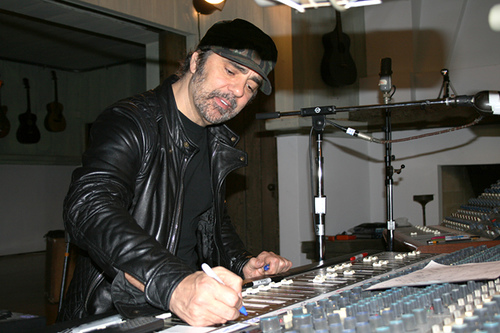In the early Eighties Peter Gabriel was the ne plus ultra of arty, experimental margin-hangers, breaking cover occasionally with an improbable hit single before “retreating back into the bushes with my normal crowd”. His fifth studio album, So, changed all that. Its lead single “Sledgehammer” strutted over the dividing line between cult kudos and mass-market kerching, leading Gabriel and the rest of this darkly soulful album straight into the arms of the mainstream. After 1986, he was one of the big beasts.
This absorbing Classic Albums film suggested there was little premeditation about any of it. So was Gabriel following not just his nose but his heart. Several tracks returned to the roots of his first love: black music. He called “In Your Eyes” a “religious love song”; “Don’t Give Up” was partly an homage to those emotionally charged soul duets of the Sixties and early Seventies. “Sledgehammer” and "Big Time" were built on thick slabs of funk. According to producer Daniel Lanois, exploring these avenues allowed Gabriel to reveal a more open, directly emotional side to his writing and music.
The director of the 'Sledgehammer' video was worried about catching salmonella from the dancing chickens
The value of any “making of” music doc rests on the quality of the talking heads and the calibre of the anecdotes. In both cases, this programme scored highly. Lanois (looking very much like the fourth member of Alvin and The Chipmunks) and engineer Kevin Killen appeared alongide So collaborator Laurie Anderson and the key players on a record built on rhythm: drummers Jerry Marotta and Manu Katché and bassists Tony Levin and Larry Klein.
They recalled arriving at an ad hoc studio built inside a barn at Gabriel's rented farmhouse outside Bath. The recording environment was likened by Lanois (pictured below) to a “construction site – we would all put on hard hats before starting work”. The cows would often wander over and start licking the windows.
 The album took almost exactly a year to make, which was fast for Gabriel. “I’m a master of distraction when I have a deadline,” he admitted. Struggling with the lyrics towards the end, he would procrastinate by making endless telephone calls, to the point where a furious Lanois was moved to grab the phone and smash it to pieces. On another occasion the producer “nailed Peter into the barn" and then went off for lunch. Gabriel eventually smashed through the door frame and asked for a quiet word. “I almost got fired but I think he got the idea...” muttered Lanois.
The album took almost exactly a year to make, which was fast for Gabriel. “I’m a master of distraction when I have a deadline,” he admitted. Struggling with the lyrics towards the end, he would procrastinate by making endless telephone calls, to the point where a furious Lanois was moved to grab the phone and smash it to pieces. On another occasion the producer “nailed Peter into the barn" and then went off for lunch. Gabriel eventually smashed through the door frame and asked for a quiet word. “I almost got fired but I think he got the idea...” muttered Lanois.
The human interest was balanced by the muso minutiae. “I have to get the drums right before I can do anything,” said Gabriel; on So cymbals and hi-hats were allowed back into the mix, having been banned on his past two albums. On “Don’t Give Up” Levin played with nappies dampening the bass strings, while Gabriel dismissed headphones as “condoms for the ears”. A follower of the perfectionist’s mantra “fabulous, fabulous, fabulous: now do it again”, he created the rhythm track on “In Your Eyes” by splicing together tiny fragments taken from 96 different takes. When Katché was called in to perform on “Sledgehammer”, the drummer played his part once and refused to do another take. The sound of So is the result of painfully constructed detail crashing into cavalier creativity.
Much of the 60 minutes inevitably centred around the album's two biggies, “Sledgehammer” and “Don’t Give Up”. (A few tracks – “That Voice Again”, “Big Time”, “We Do What We’re Told (Miligram's 37)” – were overlooked entirely). The latter, said Gabriel, started with a “little tom-tom pattern” and the image of a working man cast adrift in the Great Depression. With this in mind Dolly Parton was approached to sing the female part but “she didn’t even know who Peter Gabriel was”. Instead he asked Kate Bush, a friend who had appeared on previous records. “She was brought in as an actor,” said Lanois, who sketched out the detail in Bush's (inevitable) absence from the programme. “It was like being in the presence of royalty.”
In favouring the big picture, some of the detail was left frustratingly unexplored
“Sledgehammer” arrived at the very end of the sessions. So late, in fact, that the original intention was to hold the song over for the next album - had that been the case, the narrative surrounding So would have been considerably altered. It's hard to overstate the significance of the song in bringing Gabriel to the mainstream (or perhaps it was vice versa), nor the importance of the ground-breaking animated Aardman video in further smoothing the path. The video brought to the forefront Gabriel's charm and humour where once there had been a vague aura of foreboding. Afterwards, many more women started coming to his concerts, a fact not lost on the band (Gabriel, a famously committed swordsman in his day, would have been especially pleased. When Laurie Anderson described him as “a master of low-end” it was hard to suppress a juvenile snigger.) Equally pleasingly, we learned that the director of the video was worried about catching salmonella from the dancing chickens.
Watch the video for "Sledgehammer"
In favouring the big picture, some of the detail was left frustratingly unexplored. We were told that the poetry of Anne Sexton inspired perhaps the best song on the record, “Mercy Street”, but it would have been instructive to have delved a little deeper into this, and Gabriel’s lyrical preoccupations in general. His overall creative view was and has remained, said Anderson astutely, “forward looking”. It was a thought well worth exploring which was instead left dangling.
On the back of “Sledgehammer” – and the success of “Don’t Give Up” in the States – So elevated Gabriel to the big league, where he has remained, despite the fact that nothing he has done since has matched its impact or popularity. It remains unusual for a classic album in that its structure is fluid. The original eight-track vinyl release was quickly reshaped for CD: Gabriel added an extra song and changed the running order, offering a glimpse of the industry’s amorphous multi-format future. As ever, he seemed enigmatically ahead of the game. Then again, it was also the first of his albums to have anything so routine as an actual title. Perhaps that’s what did the trick.















Add comment